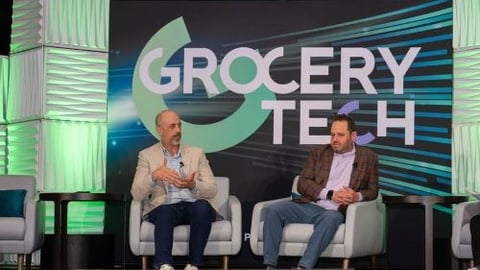Turn Data Into Dollars Through Personalization
Creating an engaging digital experience isn’t always easy for grocers, but the good folks from Mercatus are here to help. Two of the company’s executives, Chief Revenue Officer Randy Crimmins and SVP Retail Operations Lee Lambeth, were on hand last week at Progressive Grocer’s GroceryTech event in Dallas, to show “how a connected customer-first approach is not only possible, but is paying dividends already for those retailers that are committed to leveraging data and connecting the digital commerce experience,” as Crimmins put it.
To do that, retailers must first understand how their customers are going to market and how they’re determining what products to buy. “If you think about the way shoppers are looking at things today, … they’re looking at apps and sites to inform [them] before they even go into the store, before they even make that path to purchase,” explained Lambeth, “and the modern grocery shopper doesn’t think in terms of channels. They’re actually thinking in terms of moments. They make decisions based off real-time needs.”
Indeed, according to Mercatus data, more than 80 million U.S. households placed at least one online grocery order in the month of February 2025, and 90% of grocery shoppers are fluctuating between shopping online and in-store.
[RELATED: Sam’s Club Exec Tells How to Transform Retail]
Crimmins noted that this growth in online shopping is driven by mass retailers. “They’re prioritizing their investment in their digital infrastructure to drive that experience,” he said, “and simply put, regional grocers and supermarkets are not. … Walmart takes more and more market share from grocers every single day. … Over consecutive quarters, they’ve grown their e-grocery sales directly at the expense of the regional supermarkets up five full percentage points since 2022. They own the journey. They own their data; they own the customer relationship.”
Observing that regional grocers have historically relied on disparate systems that fall short on delivering the experience they want to create, he went on to ask: “What if you could lean into your service-first model and go toe to toe with the mass retailers and win because you own the ability to differentiate your experience both in store and online? You may not win on price every day, but you can win on experience every day in store and online.”
The right approach would be, as Lambeth described it, “a connected grocery platform – it’s not just a website, it’s not just an app, it’s not just a loyalty program. It’s [combining] all these parts together and then enabling a shopper experience that builds lasting relationships. This is how and why grocers have to stop thinking in terms of transactions and start thinking in terms of relationships. Switch the focus from the single transaction to the lifetime value of the customer.”
“A unified platform gets grocers beyond the transactional into the relational, and that’s where you can unlock the long-term value of a shopper,” agreed Crimmins, “but it really begins and ends with data. To be able to grow customer value, you have to understand the customer holistically. In today’s world, ‘holistic’ means you need to understand them digitally, and not at an aggregated level, but at an individual level. How do they engage with you on your digital platforms, your web, your app, your other channels, e-marketing push, SMS text – how are they engaging through all these digital touchpoints with you? You have to collect and connect data across every interaction with a customer, from impression to transaction.”
He added: “That ability to connect from impression to transaction is foundational to being able to create the digital experience that you want and that consumers expect, because they’re getting it from the mass retailers and elsewhere. It really gives you that ability to deliver a true end-to-end digital experience that’s built around personalized convenience and value, which have always been the two consumer drivers in grocery.”
This means tailoring the shopping experience to an individual shopper’s needs. For in-store shopping, this could involve the app automatically populating a shopping list, based on the items that the shopper buys the most, and the ability to edit the list, which automatically syncs with the store planogram so the shopper can find items efficiently and conveniently.
Other possibilities could include enabling the shopper to scan a barcode to read product content, and deals activated just by the shopper walking through the aisle, along with seamless product suggestions when the shopper is online that automatically pop up based on their purchase history as well as based on when they last purchased the item.
Beyond the store, this could entail seamless curbside pickup services with geolocation that automatically notify the store when the shopper is pulling into the parking lot, and options for last-mile delivery.
“Those are all ways that the digital experience is spanning both the online shopping experience into the in-store experience,” said Crimmins. “The important point is that these pieces aren't isolated actions. They're part of an orchestrated way that you surround the customer and engage with them in personally relevant, meaningful ways. Every engagement, every interaction and every purchase drives additional data that can feed back into the system. You gain additional insight that you can now operationalize further to enhance the experience. So it is a full flywheel effect being fully connected and owning it as a grocer, that experience allows you to drive your bottom line and to keep everything within your ecosystem, not someone else’s.”
The biggest advantage to adopting this strategy? “Customers who log in and shop will actually spend more revenue on a consistent basis, and a unified experience really matters,” explained Lambeth, who introduced several real-world case studies illustrating “why driving digital engagement leads to more revenue, why hybrid shoppers are your most valuable customers, and how personalized offers turn lapsed [customers] into returning [ones].”
Acknowledging the barriers to tech adoption of smaller grocery operators – limited budgets, small staffs, the risk of security breaches, and just general inertia – Crimmins and Lambeth nevertheless urged retailers to act now to upgrade their omnichannel capabilities.
“You’ve got to invest in your digital properties just like you invest in your physical properties,” advised Crimmins. “That gets you in the right mindset that the digital experience is just as important as the physical experience. So understand what cost is appropriate, what kind of return on investments you’re going to get, and create a relative benchmark.”
He went on to suggest “a microservices architecture that allows you to more easily change out components to create the experience that you want, and that can be phased in over time, because a lot of times, lift and shift is not practical to go from what you have today immediately to what you want the next day. It’s typically a phased deployment. It may be starting with your web and mobile experience, then adding in loyalty, then adding in e-commerce and adding in other components. You need to be on a platform that's extensible to where you want to go so you don't have to re-platform every two years down the road, so you can scale easily.”
The alternative to acting now is lost sales. “If you don't have [a unified platform] available to them, they’re going to go somewhere else, because there are other options,” warned Crimmins, “so you’ve got to be there and make sure that you give ’em all the different ways that they can shop at your store.”
Lambeth put it more succinctly, rejiggering a famous movie quote: “Build it right, and they will come and stay with you.”






